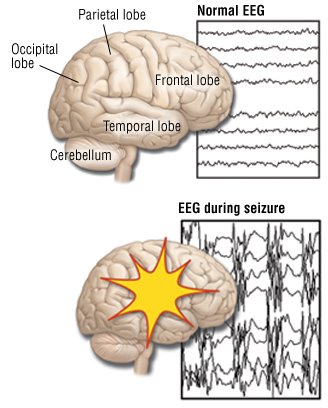Epilepsy (recurring seizures) has long been attributed to a group of abnormal neurons, known as the seizure focus, which undergoes spontaneous firing. Adjacent or distant areas of the brain are then affected as the firing spreads. If it spreads to involve the whole brain, a generalized seizure occurs. It is not clear what causes this abnormal firing, however, any stimulus that causes the cell membrane of the neuron to depolarize influences spontaneous firing. Regardless of the cause, the basic mechanism is the same: abnormal electrical discharges (1) may arise from central areas in the brain that affect consciousness; (2) may be restricted to one area of the cerebral cortex, producing manifestations characteristic of that particular anatomical focus; or (3) may begin in a localized area of the cortex and spread to other portions of the brain, which, if sufficiently extensive, produce generalized seizure activity.
While the cause is not known, we do know two things. (1) scar tissue is often found in areas of the brain from which epileptic activity arises. It is believed that these area are more likely to fire abnormally due to an interference of normal chemical and structural environment of the brain neurons. (2) a predisposition to the generation of an epileptic discharge is the activation of astrocytes by hyperactive neurons.
Seizures are classified as acute symptomatic, remote symptomatic, cryptogenic, or idiopathic Acute symptomatic seizures are associated with an acute insult such as head trauma or meningitis. Remote symptomatic seizures are those without an immediate cause but with an identifiable prior brain injury such as major head trauma, meningitis or encephalitis, hypoxia, stroke, or a static encephalopathy such as mental retardation or cerebral palsy. Cryptogenic seizures are those occurring with no clear cause. Idiopathic seizures are genetic in origin.
While we do not know what specifically causes the abnormal firing, there are many possible causes for epilepsy that vary by age.
- First 6 months: severe birth injury, congenital defects involving central nervous system, infections, and inborn errors of metabolism.
- 2-20: birth injury, infection, trauma, and genetic factors.
- 20-30: structural lesions such as trauma, brain tumors, or vascular disease.
- After 50: stoke and metastatic brain tumors.
Almost 30% of all epilepsy cases are idiopathic (idiopathic generalized epilepsy IGE). This means that they are not attributed to as specific cause. It is thought that genetic abnormalities may be the most important factor contributing to IGE. Because of the problem of separating genetic from environmental or acquired influences, the role of genetics in the cause of epilepst has been difficult to determine.
Hockenberry, M.J. & Wilson, D. (2011). Wong's nursing care of infants and children (9th ed). St. Louis: C. V. Mosby. (Wong-9th) pages 1652-1653
Lewis, M.S., Dirksen, S., & Heitkemper, M.M. et al. (2014). Medical-surgical nursing: Assessment and management of clinical problems (9th ed.). St. Louis: Mosby. (LDH-9th) page 1420



